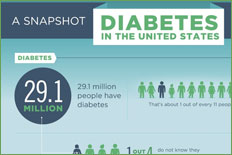Health Centers > Diabetes Center > Chronic Complications of Diabetes > Diabetes Complications
Diabetes Complications
The major cause of the high morbidity and mortality rate associated with diabetes is a group of microvascular and macrovascular complications affecting multiple organ systems. People with diabetes have a greatly increased risk for blindness, kidney failure, myocardial infarction, stroke, necessary limb amputation, and a host of other maladies. The onset and progression of these complications is strongly linked to the presence of sustained hyperglycemia. The complication rate and the severity of complications increase as the duration of diabetes increases. Other disorders (such as hypertension and dyslipidemia) commonly seen in people with diabetes increase the risk for microvascular and macrovascular complications. There may also be genetic determinants of risk for diabetic complications.
Diabetes Chronic Complications
Ocular complications
L Diabetic cataracts
L Diabetic retinopathy
L Glaucoma
Diabetic Nephropathy
L Microalbuminuria
L Progressive diabetic nephropathy
Diabetic Neuropathy
L Peripheral neuropathy
L Autonomic neuropathy
Cardiovascular complications
L Heart disease
L Peripheral vascular disease
Skin and Mucous membrane complications
Special Situations
Prognosis
Prognosis
The vascular complications result from atherosclerosis and microangiopathy. Increased lipid deposition and atheroma formation is seen in the larger blood vessels, along with increased thickness of arterial walls. Proliferation of endothelial cells, alterations in endothelial basement membranes, and changes in the function of endothelial cells induce microvascular damage.
The pathophysiology of diabetic complications is complex. There is considerable heterogeneity within the diabetic population in regard to the development and progression of diabetic complications. While poor glycemic control is clearly a major risk factor for complications, not all poorly controlled diabetic patients develop complications. Conversely, some individuals develop complications despite relatively good glycemic control. Hyperglycemia plays a major role in both microvascular and macrovascular disease. Hyperglycemia dramatically alters the function of multiple cell types and their extracellular matrix. This results in structural and functional changes in the affected tissues. Research has recently focused on lipoprotein metabolism and on the glycation of proteins, lipids, and nucleic acids as possible common links between the different diabetic complications.
The function of cell membranes is determined largely by their phospholipid bilayers; thus, changes in lipid metabolism can have major effects on cell function. The oxidation of circulating low-density lipoprotein (LDL) in hyperglycemic individuals increases oxidant stress within the vasculature. This induces chemotaxis of monocytes and macrophages into the vessel walls, where oxidized LDL causes changes in cellular adhesion and increased production of cytokines and growth factors. Growth factor-induced stimulation of smooth-muscle cell proliferation increases vessel wall thickness. Other changes include increased atheroma formation and development of microthrombi in large blood vessels and alterations in vascular permeability and endothelial cell function in the microvasculature.
The glycation of proteins, lipids, and nucleic acids increases with sustained hyperglycemia. The microvasculature of the retina, renal glomerulus, and endoneurial areas, as well as the walls of the larger blood vessels, accumulate deposits of glycated proteins called advanced glycation end products (AGEs). While all people form AGEs, the accumulation of AGEs is much greater in individuals with diabetes, especially when the diabetic state is poorly controlled. AGE formation alters the structural and functional properties of the affected tissues.
The Hypoglycemic States
Spontaneous hypoglycemia in adults is of two principal types: fasting and postprandial. Symptoms begin ...
For example, AGE formation on collagen macromolecules impairs their normal homeostatic turnover. In the walls of the large blood vessels, AGE-modified collagen accumulates, thickening the vessel wall and narrowing the lumen. AGE-modified arterial collagen immobilizes circulating LDL, contributing to atheroma formation. Accumulation of AGEs causes increased basement membrane thickness in the microvasculature of the retina and around the nerves and increased thickness of the mesangial matrix in the glomerulus. The cumulative effect of these changes is a progressive narrowing of the vessel lumen and decreased perfusion of affected tissues.
Diabetes Mellitus and Oral Diseases
Diabetes Introduction
Diabetes Epidemiology and classification
Diabetes Pathophysiology
Clinical Presentation, Laboratory findings, and Diagnosis
Diabetes Complications
Diabetes Management
L Introduction
L Oral Agents
L Insulin
Oral Diseases and Diabetes
Periodontal Health and Diabetes
Dental Management of the Diabetic Patient
Conclusion
References
AGE formation also has major effects at the cellular level, causing modifications in extracellular matrix components and changes in cell-to-matrix and matrix-to-matrix interactions. The binding of AGEs to specific cellular receptors that have been identified on the surface of smooth-muscle cells, endothelial cells, neurons, monocytes, and macrophages results in increased vascular permeability and thrombus formation, proliferation of smooth muscle in vessel walls, and phenotypic alteration in monocytes and macrophages. This last result causes hyper-responsiveness of monocytes and macrophages upon stimulation, with resultant increases in the production of proinflammatory cytokines and certain growth factors. These cytokines and growth factors contribute to the chronic inflammatory process in the formation of atherosclerotic lesions. They also significantly alter wound-healing events. Increased production of proinflammatory mediators results in increased tissue destruction in response to antigens such as the bacteria that cause periodontal disease.
These changes in protein and lipid metabolism, induced by the elevated plasma glucose levels characteristic of diabetes, may thus provide a common connection between the various diabetic complications. However, these metabolic changes vary among individuals. For example, AGEs form in both diabetic and nondiabetic people, but their accumulation is greater in those with diabetes. There is significant heterogeneity in AGE formation even within the diabetic population, and it is thought that this heterogeneity may explain (at least, in part) the variation in the incidence and progression of diabetic complications.


